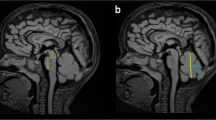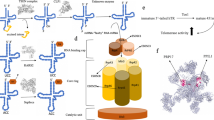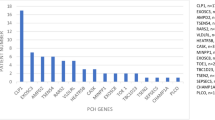Abstract
Background
Congenital central nervous system abnormalities in children with Fanconi anemia are poorly characterized, especially with regard to specific genetic complementation groups.
Objective
To characterize the impact of genetic complementation groups on central nervous system anatomy.
Materials and methods
Through chart review we identified 36 patients with Fanconi anemia with available brain MRIs at the University of Minnesota (average age, 11.3 years; range, 1–43 years; M:F=19:17), which we reviewed and compared to 19 age- and sex-matched controls (average age, 7.9 years; range, 2–18 years; M:F=9:10). Genotypic information was available for 27 patients (15 FA-A, 2 FA-C, 3 FA-G, and 7 FA-D1 [biallelic mutations in BRCA2 gene]).
Results
Of the 36 patients, 61% had at least one congenital central nervous system or skull base abnormality. These included hypoplastic clivus (n=12), hypoplastic adenohypophysis (n=11), platybasia (n=8), pontocerebellar hypoplasia (n=7), isolated pontine hypoplasia (n=4), isolated vermis hypoplasia (n=3), and ectopic neurohypophysis (n=6). Average pituitary volume was significantly less in patients with Fanconi anemia (P<0.0001) than in controls. Basal angle was significantly greater in Fanconi anemia patients (P=0.006), but the basal angle of those with FA-D1 was not significantly different from controls (P=0.239). Clivus length was less in the Fanconi anemia group (P=0.002), but significance was only observed in the FA-D1 subgroup (P<0.0001). Of the seven patients meeting criteria for pontocerebellar hypoplasia, six belonged to the FA-D1 group.
Conclusion
Patients with Fanconi anemia have higher incidences of ectopic neurohypophysis, adenohypophysis hypoplasia, platybasia and other midline central nervous system skull base posterior fossa abnormalities than age- and sex-matched controls. Patients with posterior fossa abnormalities, including pontocerebellar hypoplasia, are more likely to have biallelic BRCA2 mutations.






Similar content being viewed by others
References
Wang AT, Smogorzewska A (2015) SnapShot: Fanconi anemia and associated proteins. Cell 160:354
Kutler DI, Singh B, Satagopan J et al (2003) A 20-year perspective on the International Fanconi Anemia Registry (IFAR). Blood 101:1249–1256
Svojgr K, Sumerauer D, Alena P et al (2016) Fanconi anemia with biallelic FANCD1/BRCA2 mutations — case report of a family with three affected children. Eur J Med Genet 59:152–157
Balmana J, Diez O, Rubio T et al (2011) BRCA in breast cancer: ESMO clinical practice guidelines. Ann Oncol 22:31–34
Auerbach AD (2009) Fanconi anemia and its diagnosis. Mutat Res 668:4–10
Shimamura A, Alter BP (2010) Pathophysiology and management of inherited bone marrow failure syndromes. Blood Rev 24:101–122
Giampietro PR, Verlander PC, Auerbach AD (1997) Diagnosis of Fanconi anemia in patients without congenital malformations: an international Fanconi Anemia Registry Study. Am J Med Genet 68:56–61
Giri N, Batista DL, Alter BP et al (2007) Endocrine abnormalities in patients with Fanconi anemia. J Clin Endocrinol Metab 92:2624–2631
Deepak Amalnath S, Subramanian R, Swaminathan RP et al (2012) Incidental detection of Chiari malformation in Fanconi anemia. Br J Haematol 158:154
Alter BP (2007) Diagnosis, genetics, and management of inherited bone marrow failure syndromes. Hematology Am Soc Hematol Educ Program 2007:29–39
Dupuis-Girod S, Gluckman E, Souberbielle J et al (2001) Growth hormone deficiency caused by pituitary stalk interruption in Fanconi anemia. J Pediatr 138:129–133
Sherafat-Kazemzadeh R, Mehta SN, Care MM et al (2007) Small pituitary size in children with Fanconi anemia. Pediatr Blood Cancer 49:166–170
Stivaros S, Alston R, Wright N et al (2015) Central nervous system abnormalities in Fanconi anemia: patterns and frequency on magnetic resonance imaging. Br J Radiol 88:20150088
Alter B, Rosenberg P, Brody L (2007) Clinical and molecular features associated with biallelic mutations in FANCD1/BRCA2. J Med Genet 44:1–9
Dokal I (2006) Fanconi’s anaemia and related bone marrow failure syndromes. Br Med Bull 77–78:37–53
Ibinaiye PO, Olarinoye-Akorede S, Kajogbola O et al (2015) Magnetic resonance imaging determination of normal pituitary gland dimensions in Zaria, Northwest Nigerian population. J Clin Imaging Sci 5:29
Koenigsberg RA, Vakil N, Hong TA et al (2005) Evaluation of platybasia with MR imaging. AJNR Am J Neuroradiol 26:89–92
Voutetakis A, Sertedaki A, Dacou-Voutetakis C (2016) Pituitary stalk interruption syndrome: causes, clinical manifestations, diagnosis, and management. Curr Opin Pediatr 28:545–550
Pavlakis S, Frissora C, Giampietro P et al (1992) Fanconi anemia: a model for genetic causes of abnormal brain development. Dev Med Child Neurol 34:1081–1084
Myers K, Davies S, Harris R et al (2012) The clinical phenotype of children with Fanconi anemia caused by biallelic FANCD1/BRCA2 mutations. Pediatr Blood Cancer 58:462–465
Lubinsky M (2015) Sonic hedgehog, VACTERL, and Fanconi anemia: pathogenetic connections and therapeutic implications. Am J Med Genet 167A:2594–2598
Yaghmai R, Kimyai-Asadi A, Rostamiani K et al (2000) Overlap of dyskeratosis congenita with the Hoyeraal-Hreidarsson syndrome. J Pediatr 136:390–393
Frappart PO, Lee Y, Lamont J et al (2007) BRCA2 is required for neurogenesis and suppression of medulloblastoma. EMBO J 26:2732–2742
Frappart PO, McKinnon P (2007) BRCA2 function and the central nervous system. Cell Cycle 6:2453–2457
Ahmad SI, Kirk SH (2006) Molecular mechanisms of Fanconi anemia. Springer Science+Business Media, New York
McKinnon PJ (2004) ATM and ataxia telangiectasia. EMBO Rep 5:772–776
De Kerviler E, Guermazi A, Zagdanski A et al (2000) The clinical and radiological features of Fanconi’s anaemia. Clin Radiol 55:340–345
Schady W, Metcalfe R, Butler P (1987) The incidence of craniocervical bony anomalies in the adult Chiari malformation. J Neurol Sci 82:193–203
Akiyama K, Koh H, Mori M et al (2013) Association between Chiari malformation and bone marrow failure/myelodysplastic syndrome. Br J Haematol 163:404–420
Author information
Authors and Affiliations
Corresponding author
Ethics declarations
Conflicts of interest
None
Rights and permissions
About this article
Cite this article
Johnson-Tesch, B.A., Gawande, R.S., Zhang, L. et al. Fanconi anemia: correlating central nervous system malformations and genetic complementation groups. Pediatr Radiol 47, 868–876 (2017). https://doi.org/10.1007/s00247-017-3817-x
Received:
Revised:
Accepted:
Published:
Issue Date:
DOI: https://doi.org/10.1007/s00247-017-3817-x




